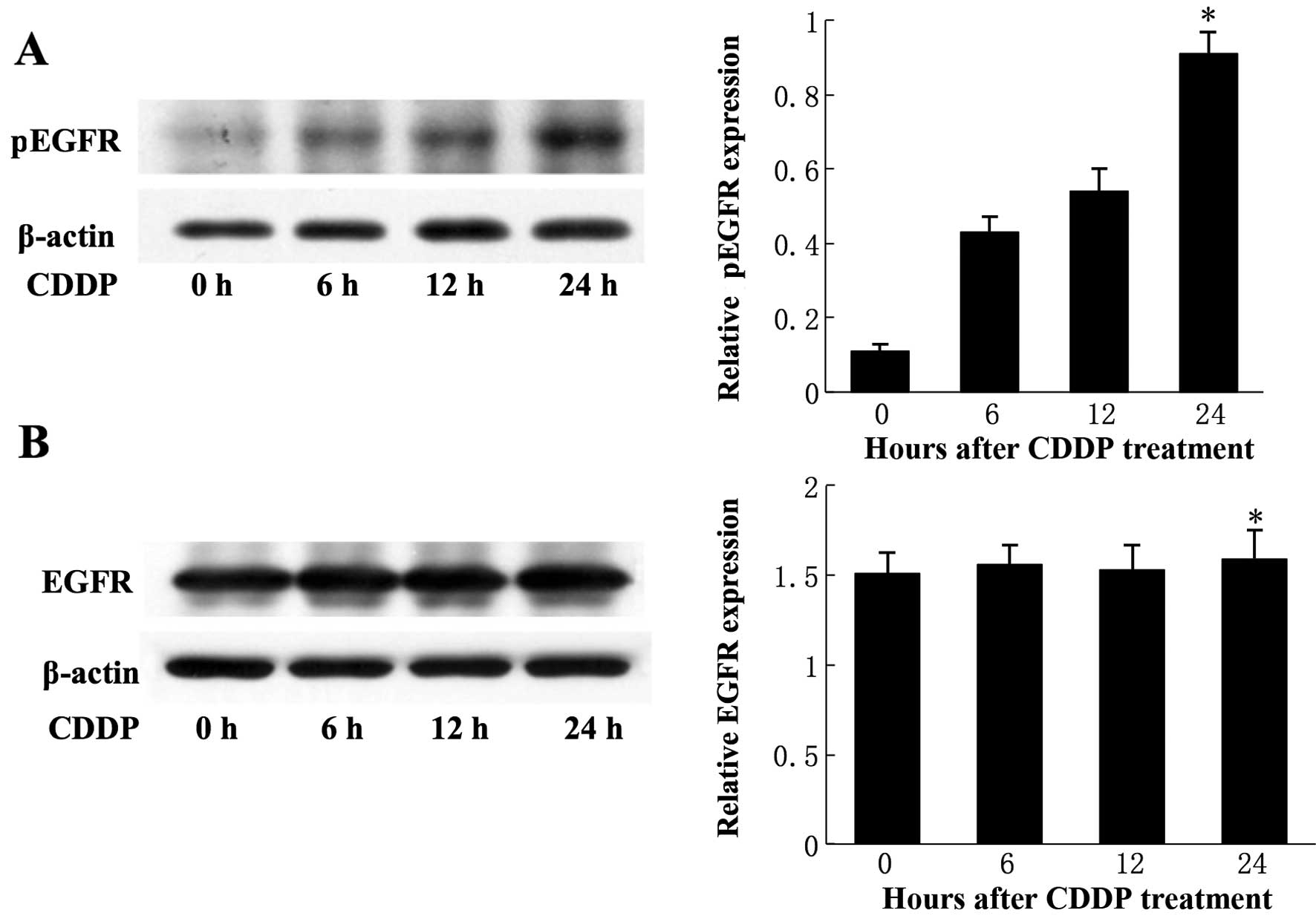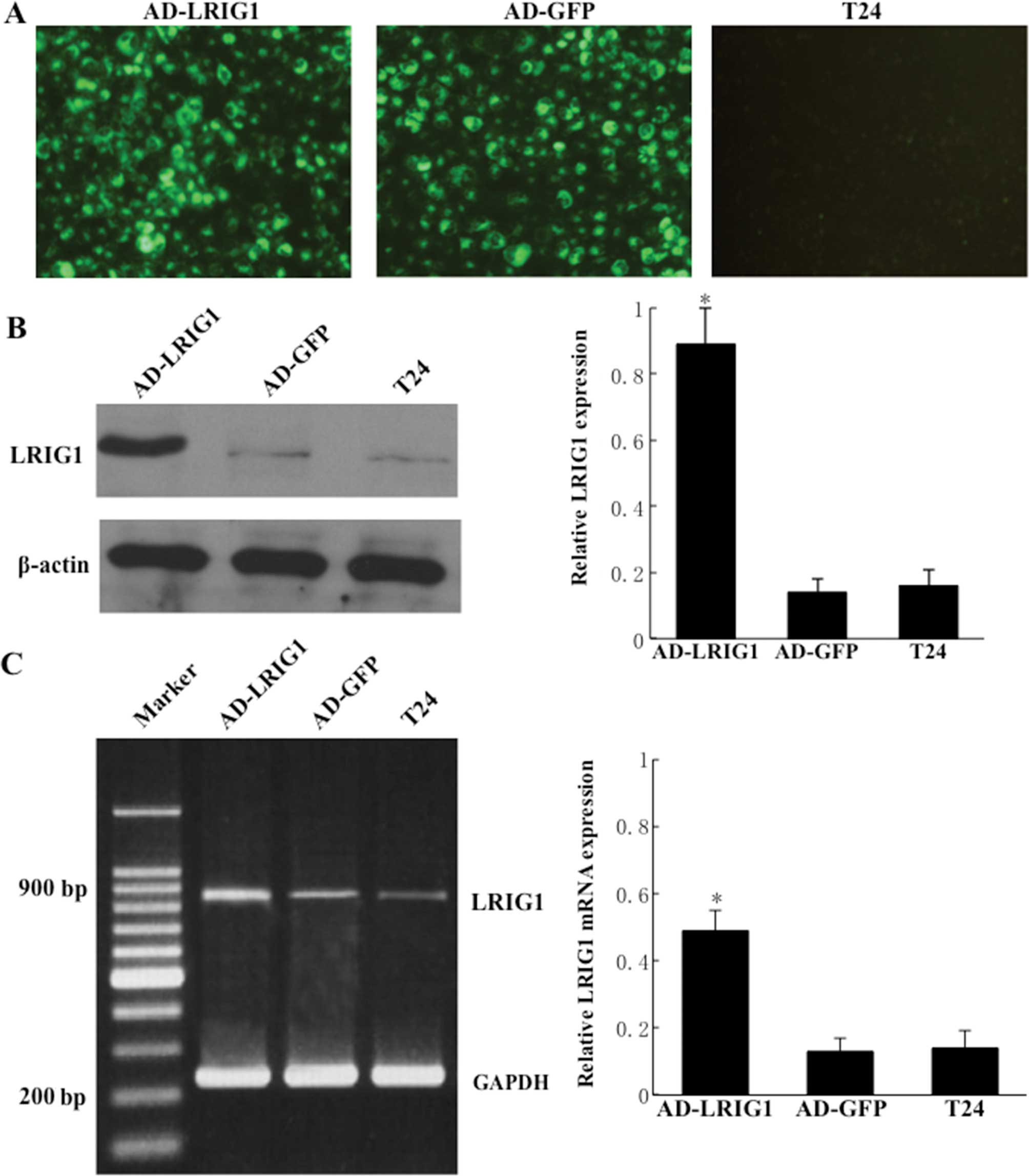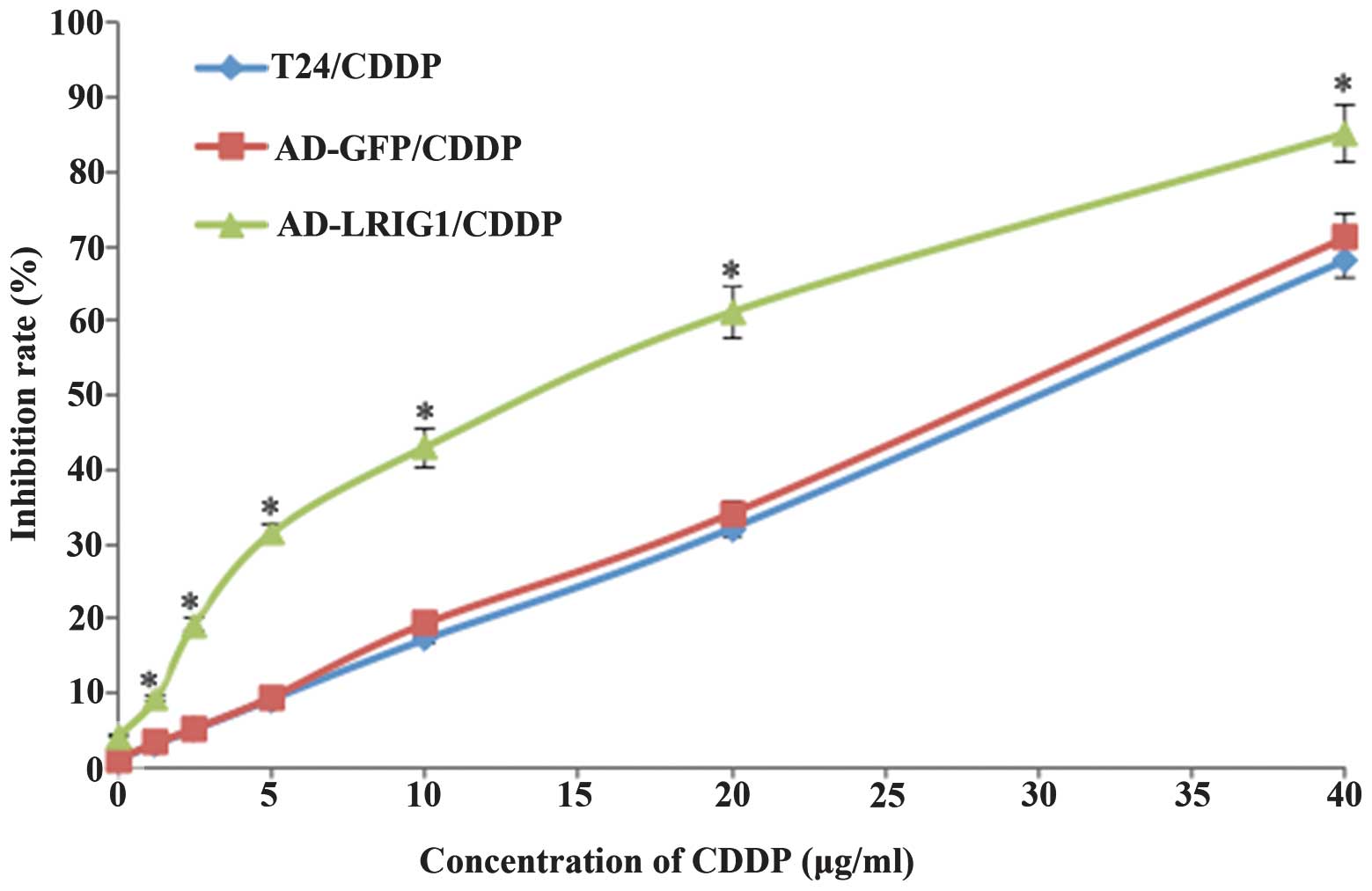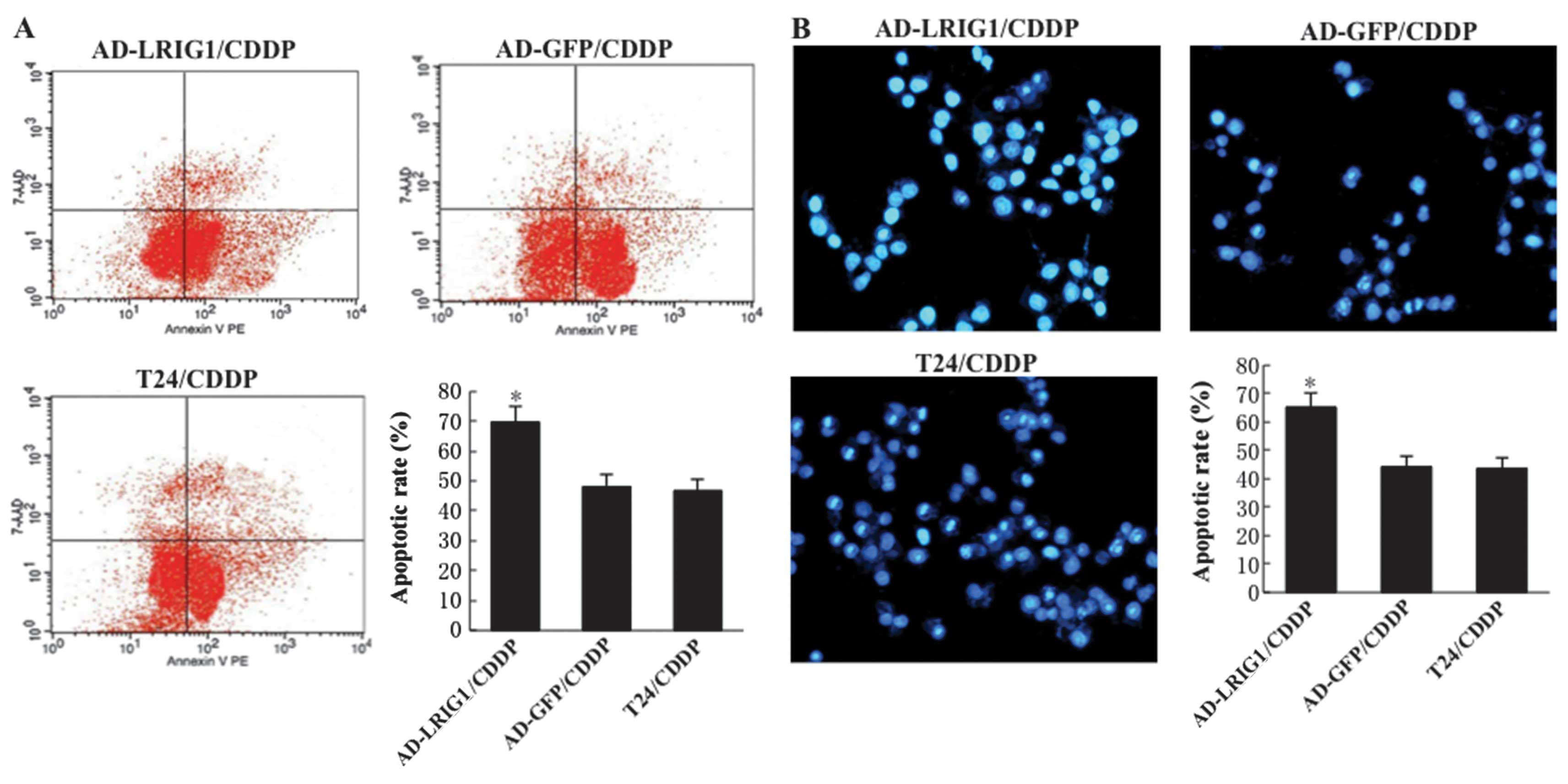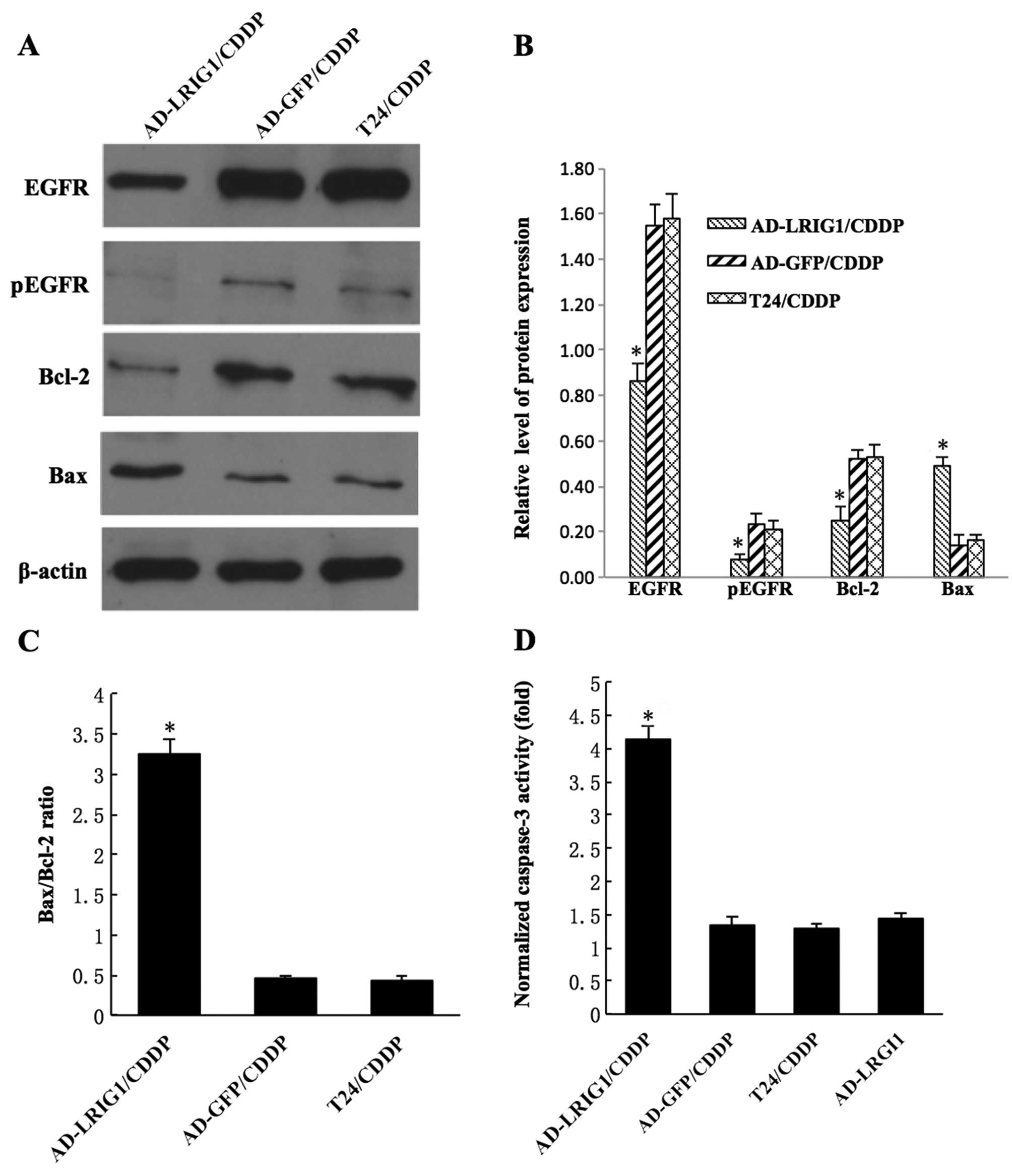Adenovirus-mediated LRIG1 expression enhances the chemosensitivity of bladder cancer cells to cisplatin
- Authors:
- Published online on: February 16, 2015 https://doi.org/10.3892/or.2015.3807
- Pages: 1791-1798
Abstract
Introduction
Bladder cancer is the fourth most common malignant disease worldwide, accounting for ~6% of all cancer cases (1). Bladder cancers (75%) are non-muscle-invasive and can be treated by transurethral resection of the bladder tumor combined with intravesical chemotherapeutic agents instillation. However, the prognosis of patients with muscle invasive bladder cancer (25%) remains poor despite the many advances in treatments made over the past few decades. To improve survival rate and extend life span, patients with muscle invasive bladder cancer require chemotherapy after surgery (2). Cisplatin (CDDP)-based chemotherapy is widely used for treatment of muscle invasive bladder cancer (3). However, cancer cell resistance to CDDP is a major obstacle to the effective treatment of bladder cancer, and the underlying mechanism of the resistance is unclear.
The molecular mechanisms of CDDP include binding of the drug to DNA and non-DNA targets to form a variety of monoadducts and cross links, which contribute to the cytotoxicity of CDDP by blocking DNA replication and stimulating signals for apoptosis (4). Despite the excellent anticancer effect, CDDP results in severe side effects such as nephrotoxicity, ototoxicity, hepatotoxicity, peripheral neuropathy and asthenia after prolonged clinical exposure (5). In addition, intrinsic resistance and/or the resistance developed by cancer cells to CDDP result in failure in the therapy of bladder cancer (6). Due to the side effects and drug resistance, wide use of CDDP is restricted. Thus, the important task of bladder cancer therapy is to identify a suitable method to improve the sensitivity of cancer cells to CDDP to enhance its efficacy. Previous results have demonstrated that the combination of gene therapy and chemotherapeutic agents are crucial in the treatment of cancer (7).
Leucine-rich repeats and immunoglobulin-like domains 1 (LRIG1) is a transmembrane leucine-rich repeat and immunoglobulin (Ig)-like domain-containing protein, whose encoding gene is located at chromosome 3p14.3, a region that is frequently deleted in various human cancers (8,9). The expression of LRIG1 is downregulated in several tumors, such as breast tumor, renal cell and lung carcinoma, and bladder cancer (10,11). Further studies showed that LRIG1 is one of the natural ligands of EGFR and acts as a negative regulator of the ErbB family of receptor tyrosine kinases (12). EGFR is a widely distributed protein tyrosine kinase that is overexpressed in many types of tumor cells, including colon, bladder, lung and prostatic carcinoma, and there is an association between the upregulation of EGFR and poor clinical prognosis (13,14). EGFR can be activated by epidermal growth factor (EGF) and transforming growth factor-α (TGF-α), while activated EGFR (phosphorylated EGFR, pEGFR) stimulates several different signal transduction pathways, such as the phosphoinositide-3 kinase (PI3K)/Akt pathway, the phospholipase-Cγ/protein kinase C pathway and the Ras/mitogen-activated protein kinase pathway. These signal transduction pathways activated by pEGFR are important in cell differentiation, proliferation, migration, adhesion and apoptosis (15). It has been reported that the chemoresistance of several types of tumors including bladder cancer are associated with EGFR and pEGFR overexpression (16,17). These findings indicated that LRIG1 may enhance the sensitivity of cancer cells to chemotherapeutic agents.
In the present study, we upregulated the expression of LRIG1 by adenovirus vector and determined the effects of LRIG1 on chemosensitivity in the T24 bladder cancer cell line and investigated the possible mechanisms.
Materials and methods
Cell line and cell culture
The human T24 bladder cancer cell line and human QBI-293A embryonic kidney cell line were purchased from the American Type Culture Collection (ATCC; Manassas, VA, USA). The cells were maintained at 37°C in a humidified atmosphere of 5% CO2 in RPMI-1640 medium supplemented with 10% (v/v) fetal bovine serum (FBS) (Gibco-BRL, Gaithersburg, MD, USA). The medium was replaced every 3 days.
Main reagents
CDDP was purchased from the Qilu Pharmaceutical Co., Ltd. (Shandong, China). FBS, RPMI-1640, Lipofectamine 2000 and TRIzol™ reagents were purchased from Life Technologies Inc. (Carlsbad, CA, USA). MTT and dimethyl sulfoxide (DMSO) were obtained from Sigma Chemical Inc. (St. Louis, MO, USA). Polyclonal rabbit anti-LRIG1 antibody was purchased from Agrisera, Sweden. Polyconal rabbit anti-EGFR antibody, anti-phospho-EGFR (anti-pEGFR), anti-Bcl-2, anti-Bax and anti-caspase-3 were purchased from Santa Cruz Biotechnology, Inc. (Santa Cruz, CA, USA). The recombinant adenovirus-encoding human LRIG1 (Ad-LRIG1) and recombinant adenovirus (Ad-GFP) carrying the green fluorescent protein were constructed in our laboratory (18).
Cell transfection and viral infection
The Ad-LRIG1 and control Ad-GFP adenoviruses were prepared as previously described (18). Titers of purified adenoviruses were measured using the gene transfer unit (GTU) method by calculating the number of reporter gene GFP-expressing QBI-293A cells within 18 h after adenoviral infection under fluorescence microscopy. To evaluate the optimal multiplicity of infection (MOI) for a maximal infection and transgene expression, the T24 human bladder cancer cells were infected with Ad-LRIG1 and Ad-GFP at various MOIs (0, 1, 10, 25, 50, 100 and 200) for 24 h, respectively. The adenoviral infection efficiency was assessed based on GFP expression. LRIG1 gene expression in T24 cells was then examined using RT-PCR and western blot analysis.
RT-PCR analysis
Total RNA was extracted from Ad-LRIG1 or Ad-GFP infected and uninfected T24 cells using TRIzol reagent according to the manufacturer’s instructions. Total RNA (3 μg) was reverse transcribed using M-MuLV reverse transcriptase (Promega, Madison, WI, USA). cDNA was amplified by PCR using Taq DNA Polymerase (Promega). The primers used were: LRIG1, sense: 5′-ATCATCACCCAGCCAGAAAC-3′ and antisense: 5′-CTACCGTGGTCCCATCCTT-3′ (product size, 892 bp); GAPDH, sense: 5′-ACGGATTTGGTCGTATTGGG-3′ and antisense: 5′-TGATTTTGGAGGGATCTCGC-3′ (product size, 230 bp). The reaction conditions were as follows: denaturation for 30 sec at 94°C, 1 min at 58°C, annealing 1 min at 72°C, 31 cycles and a final extension at 72°C for 10 min. The PCR products were separated in 1.5% agarose gel electrophoresis with ethidium bromide staining.
Western blot analysis
The cells (n=1×106) were washed twice in ice-cold phosphate-buffered saline (PBS). Total proteins were extracted from Ad-LRIG1 or Ad-GFP infected and uninfected T24 cells, respectively, using Mammalian Protein Extraction Reagent (Pierce, Rockford, IL, USA) according to the manufacturer’s instructions. The protein concentrations were measured using a Lowry protein assay (Bio-Rad, Hercules, CA, USA). Cell lysates (30 μg of each sample) were diluted with 2X SDS sample buffer (125 mM Tris, 2.2 M glycerol, 1.42 M β-mercaptoethanol, 160 mM SDS, 10 mg/l bromophenol blue, pH 0.8), boiled for 10 min and analyzed by SDS-PAGE (8%), and then transferred to a membrane (Millipore) and incubated with 5% non-fat dry milk overnight. The membrane was washed with PBS-0.1% Tween-20 (Sigma) and incubated with antibodies such as LRIG1 (rabbit anti-human IgG, 1:300 dilution), EGFR (rabbit anti-human IgG, 1:300 dilution), pEGFR (rabbit anti-human IgG, 1:300 dilution), Bax (rabbit anti-human IgG, 1:200 dilution), Bcl-2 (rabbit anti-human IgG, 1:200 dilution), caspase-3 (rabbit anti-human IgG, 1:600 dilution) and β-actin (rabbit anti-human IgG, 1:600 dilution) for 1 h at 37°C. The membrane was then washed three times with TBST and incubated with a peroxidase horseradish peroxidase-conjugated secondary antibodies in blocking solution for 90 min at 37°C. After three washes with TBST, the blots were detected by ECL western blotting detection system (Amersham, Aylesbury, UK). Band intensities shown by western blotting were semi-quantified by densitometry.
Cell growth inhibitory rate assay with CCK-8
The sensitivity of cells to CDDP was assayed with the Cell Counting Kit-8 (CCK-8) kit (Dojindo Molecular Technologies, Gaithersburg, MD, USA). Briefly, T24 cells infected with Ad-LRIG1 or Ad-GFP and uninfected T24 cells were seeded in 96-well culture plates (1×104/well) and incubated for 24 h at 37°C and then treated with CDDP at concentrations of 0, 1.25, 2.5, 5, 10, 20 and 40 μg/ml for 24 h to obtain a dose-response curve. Cell viability of the three groups was then analyzed by CCK-8 kit according to the manufacturer’s instructions. The values of each well were measured by a microplate reader at 450 nm. The inhibitory rate (%) was calculated according to the formula: (1 - experimental OD value/control OD value) ×100%. The experiments were carried out in triplicate. Dose-dependent response curves were plotted on the basis of the data derived from the CCK-8 assay. The half maximal inhibitory concentration (IC50) was determined graphically from the concentration response curves.
Annexin V-APC/7-AAD double labeling for FCM-assessed apoptosis
The Annexin V-APC (Bender MedSystems, Vienna, Austria) was used to detect apoptosis according to the manufacturer’s instructions. Synchronization was achieved by serum starving cells for 24 h. The cells were then collected by trypsinization and washed twice with cold PBS (0.1 M, pH 7.2). The cells were centrifuged at 2,000 rpm for 5 min, the supernatant was discarded and the pellet was re-suspended in 1X binding buffer at a density of 1×106 cells/ml. Each suspension (100 μl) was transferred into individually labeled tubes and incubated with 5 μl of APC-conjugated Annexin V and 5 μl of 7-AAD (KeyGene Co., Nanjing, China) for 15 min at room temperature in the dark. PBS binding buffer (500 μl) was added to each sample tube without washing and analyzed within 1 h by FACS using CellQuest Research Software (BD Biosciences, San Jose, CA USA). Each group was measured three times.
Analysis of chemosensitizing effects
To assess the chemosensitizing effects of Ad-LRIG1, the following groups were studied: CDDP+T24 (T24/CDDP), Ad-GFP+CDDP+T24 (Ad-GFP/CDDP) and Ad-LRIG1+CDDP+T24 (Ad-LRIG1/CDDP). T24 cells (1×106/well) were cultured in 6-well culture plates (marked A–F, respectively) for 24 h, then 25 MOI Ad-LRIG1 was added into wells A and B, 25 MOI Ad-GFP was added into wells C and D, and equivalent PBS was added into wells E and F as controls. After 24 h, 30 μg/ml CDDP was added into each well. After 24 h, all the groups were harvested and washed twice with ice-cold PBS, the apoptotic rate was examined by flow cytometry (BD Biosciences) with the Annexin V-PE/7-AAD apoptosis detection kit (Wuhan, China) according to the manufacturer’s instructions. Briefly, the cells (1×106) were incubated with 5 μl Annexin V-PE and 5 μl 7-AAD in 100 μl 1X Annexin V-binding buffer at room temperature. Following incubation for 15 min, 400 μl of 1X binding buffer was added, and the apoptotic cells were analyzed by FACS using CellQuest version 3.3 software. Each experiment was repeated three times.
Hoechst staining assay
T24, T24/Ad-LRIG1 and T24/Ad-GFP cells (1×106, respectively) were cultured in 6-well culture plates for 24 h, and then treated with CDDP for an additional 24 h. Hoechst 33342 (BD Biosciences) was then added to the culture medium of living cells, and changes in nuclear morphology were detected by fluorescence microscopy (Nikon, Tokyo, Japan) with a filter for Hoechst 33342 (365 nm). The percentages of the Hoechst-positive nuclei/optical field (≥50 fields) were counted.
Caspase-3 activity assay
Caspase-3 activity was measured with a caspase-3 cellular activity assay kit (Nanjing KeyGen Biotech, Co., Ltd. China) according to the manufacturer’s instructions. Briefly, T24, T24/Ad-LRIG1 and T24/Ad-GFP cells (1×106, respectively) were cultured in 6-well culture plates for 24 h. The cells were treated with CDDP for another 24 h and harvested, resuspended in 50 μl of lysis buffer and incubated on ice. After 30 min, the cell debris was pelleted and the lysates (50 μl) were transferred to 96-well plates. The lysates were added to 50 μl 2.0X reaction buffer together with 5 μl caspase-3 substrate and incubated for 4 h at 37°C, 5% CO2 incubator. The activities were quantified spectrophotometrically at a wavelength of 405 nm.
Statistical analysis
Data were presented as the means ± standard deviation (SD). Statistical analyses were performed using SPSS version 13 (SPSS, Inc., Chicago, IL, USA). Statistical significance between two groups was determined by the paired or unpaired Student’s t-test. Comparisons between multiple groups were performed by one-way analysis of variance. P<0.05 was considered to indicate a statistically significant result.
Results
CDDP induces phosphorylation and activation of EGFR in T24 cells
CDDP (30 μg/ml) induced the activation of EGFR in T24 cells in a time-dependent manner (Fig. 1A). The level of phosphorylated EGFR (pEGFR) in T24 cells increased with time and reached a peak of ~5-fold compared to the baseline level (P<0.05) at 24 h. However, there was no significant difference in the total level of EGFR expression in T24 cells at different time points (P>0.05) (Fig. 1B). Taken together, these results demonstrated that CDDP induced the activation of EGFR in T24 cells and suggested that CDDP specifically activates EGFR but has no effect on EGFR expression.
Adenovirus-mediated overexpression of LRIG1 in T24 cells
To determine the optimal MOI for a maximal gene transfer with minimal adenovirus itself-induced cytotoxicity, the T24 cells were infected with Ad-LRIG1 or Ad-GFP at different MOIs and observed under fluorescence microscopy (488 nm; Nikon). Over 80% of GFP expression was found in the Ad-LRIG1- or Ad-GFP-infected T24 cells at a MOI of ≥25. However, green fluorescence was not identified in uninfected T24 cells (Fig. 2A). Furthermore, adenovirus-mediated exogenous LRIG1 gene was significantly expressed in 25 MOI Ad-LRIG1-infected T24 cells but not in Ad-GFP-infected and uninfected T24 control cells (Fig. 2B and C). Additionally, there was a negligible adenovirus-elicited cytotoxic effect in 25 MOI blank Ad-GFP-infected T24 cells. These results showed that 25 MOI serves as an optimal dose for adenovirus-mediated LRIG1 transgene expression in T24 cells.
Effect of LRIG1 on the sensitivity to CDDP in T24 cells
T24 cells infected with Ad-LRIG1 or Ad-GFP and uninfected T24 cells were treated with CDDP at different concentrations. After 24 h, the cell viability was reduced with increasing concentrations of CDDP (Fig. 3). The levels of cytotoxicity were indicated as the concentration that inhibits the response by 50%, IC50 value. The IC50 values in Ad-LRIGl/CDDP, Ad-GFP/CDDP and T24/CDDP were (14.09±0.31, 31.55±0.48 and 30.96±0.57), respectively. Data showed that LRIG1 over-expression was able to enhance the sensitivity of T24 cells to CDDP (P<0.05). Since the IC50 value in T24 cells (T24/CDDP) was (30.96±0.57 μg/ml), the concentration of CDDP intervention in subsequent experiments was determined as 30 μg/ml.
Effects of LRIG1 on CDDP-induced apoptosis in T24 cells
To determine whether the LRIG1 gene plays an important role in CDDP-induced apoptosis, we overexpressed LRIG1 by Ad-LRIGl recombinant adenovirus transduction in T24 cells, followed by treatment with 30 μg/ml CDDP for 24 h. After 24 h of CDDP treatment, only (46.82±3.73 and 48.15±4.21%) of the cells underwent apoptosis in T24/CDDP and Ad-GFP/CDDP cells, and the apoptotic rate of Ad-GFP-transfected cells treated with CDDP showed no significant difference compared with that of T24 cells treated with CDDP (P>0.05). By contrast, (69.77±5.14%) of the Ad-LRIGl-transfected cells underwent apoptosis (P<0.05) (Fig. 4A). Fig. 4B demonstrates the results of the Hoechst staining assay, which confirmed the results of the flow cytometric assay. The results indicated that LRIG1 was able to promote the CDDP-induced apoptosis in T24 cells.
The mechanism of upregulation of LRIG1 enhances CDDP- induced apoptosis in T24 cells
As shown in Fig. 5A and B, following treatment with 30 μg/ml CDDP for 24 h, the level of pEGFR in the AD-LRIG1/CDDP cells (0.08±0.02) was markedly lower than those in AD-GFP/CDDP (0.23±0.05) and T24/CDDP (0.21±0.04) cells (P<0.05). Similarly, the EGFR protein expression in AD-LRIG1/CDDP cells (0.86±0.08) was markedly lower than that in AD-GFP/CDDP (1.55±0.09) and T24/CDDP (1.58±0.11) cells (P<0.05). AD-LRIG1/CDDP cells had a higher level of the Bax protein and a lower level of the Bcl-2 protein compared with the AD-GFP/CDDP and T24/CDDP cells (P<0.05). The Bax/Bcl-2 ratio in AD-LRIG1/CDDP cells (3.25±0.19) was higher than that in the AD-GFP/CDDP (0.46±0.04) and T24/CDDP (0.43±0.06) cells (P<0.05)(Fig. 5C). Caspase-3 activity in AD-LRIG1/CDDP cells (4.14±0.21) was markedly increased compared with Ad-GFP/CDDP (1.34±0.12), T24/CDDP (1.29±0.07) and Ad-LRIGl (not treated with CDDP) (1.44±0.08) cells (P<0.05) (Fig. 5D). The results suggest that the mitochondria-mediated apoptotic pathway is involved in the upregulation of LRIG1 expression and enhances CDDP-induced apoptosis of T24 cells.
Discussion
As one of the most effective chemotherapeutic agents, CDDP is widely used in the treatment of many malignancies, including bladder cancer (19). However, the serious side effects of CDDP and inherent or acquired resistance of tumor cells to CDDP are obstacles that have to be overcome by clinicians. To overcome cellular resistance of tumor to CDDP, even a small increase in dose can cause severe cytotoxicity to normal cells. Thus, it is imperative to examine novel chemosensitizers to reduce drug dosage, minimize adverse reactions, improve the efficacy of therapy and promote the application of CDDP in cancer chemotherapy. Over the past decade, chemogene therapy-chemotherapy agents combined with gene therapy, has been developed as a novel adjuvant therapeutic strategy for cancer treatment (7,20).
Previous findings have confirmed that EGFR and its signaling pathways played an important role in the chemoresistance of cancer cells against CDDP-induced cell apoptosis (21,22). CDDP-resistant cancer cells have altered response to the EGF ligand and enhanced the activation of EGFR (23). pEGFR is the activated form of EGFR (24), CDDP induces EGFR activation through the phosphorylation of tyrosine 845, which stabilizes the activation loop of EGFR, maintains the enzyme in the active state, provides a binding surface for protein substrates and leads to cell survival (25). Thus, the upregulation of pEGFR expression may be a survival response to exposure of tumor cells to chemotherapeutic drugs. In the present study, we found that after exposure to CDDP, pEGFR expression was significantly increased, suggesting a potential mechanism through which T24 cells demonstrate chemoresistance to CDDP. According to the findings of Zhang et al (21), EGFR-tyrosine kinase inhibitor (AG1478) increased the apoptosis of the human U87 glioma cell line induced by CDDP. Thus, inhibition of the EGFR signaling pathway and reduction of the pEGFR expression may enhance the chemosensitivity of bladder cancer cells to CDDP.
LRIG1 protein is a negative regulator of the EGFR signaling pathway (26). The inactivation of LRIG1 in rodents promotes skin epidermal cell hyperplasia, suggesting involvement in EGFR signaling regulation (27). The upregulation of the LRIG1 transcript and protein levels was found to promoted ubiquitylation and degradation of EGFR by the receptor combination of leucine-rich repeat (LRR) as well as immunoglobulin-like (Ig) domains of the LRIG1 protein (12). In a preliminary study we showed that upregulation of LRIG1 expression by plasmid transfection in the human BIU87 bladder cancer cell line resulted in cell cycle arrest, inhibition of cell proliferation, promotion of cell apoptosis and attenuation of cell invasive and metastatic abilities in vitro by downregulating the expression of EGFR (10).
In this study, the expression of LRIG1 was upregulated by the adenovirus vector AD-LRIG1. The present experiments have demonstrated that the increase in LRIG1 expression strengthened the apoptosis-inducing effects of CDDP by Annexin V-FITC/PI-positive flow cytometry and Hoechst staining assays. The results were consistent with the study of Guo et al (28), which reported that the upregulation of LRIG enhanced apoptosis in glioma cells induced by CDDP in vitro. In addition, the western blot assay was used to detect the level of protein expression of LRIG1, EGFR, pEGFR, Bcl-2 and Bax and caspase-3 activity was evaluated using a caspase-3 colorimetric assay kit. The expression of EGFR and pEGFR protein in T24 cells infected with AD-LRIG1 was markedly lower than that of T24 cells infected with AD-GFP and uninfected cells. Upregulation of the LRIG1 expression in combination with CDDP decreased the cellular activity level of Bcl-2 while increasing the cellular activity levels of Bax and caspase-3. This is consistent with the functional mechanism of upregulation of LRIG1 alone, which inactivated the EGFR signaling pathway and activated the mitochondrial pathway of apoptosis. These findings have demonstrated that the upregulation of LRIG1 expression may lead to inactivation of the EGFR signaling pathway, thereby sensitizing T24 cells to CDDP-induced apoptosis and minimizing resistance of T24 cells to CDDP.
The mitochondrial pathway of apoptosis is mainly regulated by mitochondria-related Bcl-2 family members, such as Bcl-2 and Bax (29). Bcl-2 is a 28-kDa integral, intracellular membrane protein that prevents cells from undergoing apoptosis in response to a variety of cell death signals. It negatively regulates the activation of caspase-3, the key executioner of apoptosis, which functions as an effector of mammalian cell death pathways. Overexpression of Bcl-2 inhibits caspase activities and apoptosis (30,31). Bax is a 23-kDa proapoptotic protein, and decreased levels of Bax in tumor cells lead to resistance to apoptosis (32). Previous studies have shown that Bcl-2 acts on mitochondria to stabilize membrane integrity. However, Bax acts to damage the mitochondrial membrane structure directly. The ratio of Bax/Bcl-2 can function as a margin to determine cell fate. When the ratio of Bax/Bcl-2 increases, caspase-3 is activated and cells undergo apoptosis (33). The present study results show upregulation of the LRIG1-inactivated EGFR singaling pathway, resulting in a decrease in the Bcl-2 level, with a concurrent increase in the Bax level and caspase-3 activation. CDDP-induced apoptosis is generally considered to result from an increase in the Bax/Bcl-2 ratio and caspase-3 activation (34). However, the ratio of Bax/Bcl-2 and activity of caspase-3 in the presence of combined upregulation of LRIG1 expression with CDDP administration was much higher than that of the upregulation of LRIG1 expression or CDDP administration alone. The results suggest that CDDP-induced apoptosis may be enhanced by upregulation of LRIG1 via the mitochondrial pathway of apoptosis.
Taken together, our data have demonstrated that upregulation of the expression of LRIG1 inhibited EGFR signaling pathway, activated the mitochondrial pathway of apoptosis and eventually increased the sensitivity of bladder cancer cells to CDDP. LRIG1 is a promising target for chemogene therapy with CDDP, suggesting that the upregulation of LRIG1 expression and appropriate combination of CDDP administration is a potential strategy for the treatment of human bladder cancer in future.
Acknowledgements
This study was supported by grants from the China Postdoctoral Science Foundation funded project (no. 2013M541524), the Zhejiang Provincial Natural Science Foundation of China (no. LY12H05002), the Zhejiang Provincial Medicines Health Science and Technology Program Foundation of China (no. 2013KYA180), and the Ningbo Municipal Natural Science Foundation of China (no. 2013A610208).
Abbreviations:
|
CDDP |
cisplatin |
|
EGFR |
epidermal growth factor receptor |
|
FCM |
flow cytometry |
|
GFP |
green fluorescence protein |
|
LRIG1 |
leucine-rich repeats and immunoglobulin-like domains 1 |
|
MOI |
multiplicity of infection |
|
pEGFR |
phosphorylation EGFR |
|
RT-PCR |
reverse-transcription polymerase chain reaction |
References
|
Siegel R, Naishadham D and Jemal A: Cancer statistics, 2013. CA Cancer J Clin. 63:11–30. 2013. View Article : Google Scholar : PubMed/NCBI | |
|
Herr HW, Dotan Z, Donat SM and Bajorin DF: Defining optimal therapy for muscle invasive bladder cancer. J Urol. 177:437–443. 2007. View Article : Google Scholar : PubMed/NCBI | |
|
Als AB, Sengelov L and von der Maase H: Long-term survival after gemcitabine and cisplatin in patients with locally advanced transitional cell carcinoma of the bladder: focus on supplementary treatment strategies. Eur Urol. 52:478–486. 2007. View Article : Google Scholar : PubMed/NCBI | |
|
Basu A and Krishnamurthy S: Cellular responses to cisplatin-induced DNA damage. J Nucleic Acids. 2010:2013672010. View Article : Google Scholar : PubMed/NCBI | |
|
Ciarimboli G: Membrane transporters as mediators of cisplatin side-effects. Anticancer Res. 34:547–550. 2014.PubMed/NCBI | |
|
Li QQ, Wang G, Liang H, Li JM, Huang F, Agarwal PK, Zhong Y and Reed E: β-Elemene promotes cisplatin-induced cell death in human bladder cancer and other carcinomas. Anticancer Res. 33:1421–1428. 2013.PubMed/NCBI | |
|
Sekine I, Minna JD, Nishio K, Saijo N and Tamura T: Genes regulating the sensitivity of solid tumor cell lines to cytotoxic agents: a literature review. Jpn J Clin Oncol. 37:329–336. 2007. View Article : Google Scholar : PubMed/NCBI | |
|
Nilsson J, Vallbo C, Guo D, Golovleva I, Hallberg B, Henriksson R and Hedman H: Cloning, characterization, and expression of human LIG1. Biochem Biophys Res Commun. 284:1155–1161. 2001. View Article : Google Scholar : PubMed/NCBI | |
|
Hedman H, Nilsson J, Guo D and Henriksson R: Is LRIG1 a tumour suppressor gene at chromosome 3p14.3? Acta Oncol. 41:352–354. 2002. View Article : Google Scholar : PubMed/NCBI | |
|
Yang WM, Yan ZJ, Ye ZQ and Guo DS: LRIG1, a candidate tumour-suppressor gene in human bladder cancer cell line BIU87. BJU Int. 98:898–902. 2006. View Article : Google Scholar : PubMed/NCBI | |
|
Hedman H and Henriksson R: LRIG inhibitors of growth factor signalling - double-edged swords in human cancer? Eur J Cancer. 43:676–682. 2007. View Article : Google Scholar : PubMed/NCBI | |
|
Gur G, Rubin C, Katz M, et al: LRIG1 restricts growth factor signaling by enhancing receptor ubiquitylation and degradation. EMBO J. 23:3270–3281. 2004. View Article : Google Scholar : PubMed/NCBI | |
|
Yarden Y: The EGFR family and its ligands in human cancer: signalling mechanisms and therapeutic opportunities. Eur J Cancer. 37:3–8. 2001. View Article : Google Scholar | |
|
Pedersen MW, Melthorn M, Damstrup L and Poulsen HS: The type III epidermal growth factor receptor mutation. Biological significance and potential target for anti-cancer therapy. Ann Oncol. 12:745–760. 2001. View Article : Google Scholar : PubMed/NCBI | |
|
Sebastian S, Settleman J, Reshkin SJ, Azzariti A, Bellizzi A and Paradiso A: The complexity of targeting EGFR signalling in cancer: from expression to turnover. Biochim Biophys Acta. 1766:120–139. 2006.PubMed/NCBI | |
|
Kim WT, Kim J, Yan C, et al: S100A9 and EGFR gene signatures predict disease progression in muscle invasive bladder cancer patients after chemotherapy. Ann Oncol. 25:974–979. 2014. View Article : Google Scholar : PubMed/NCBI | |
|
Hiraishi Y, Wada T, Nakatani K, Tojyo I, Matsumoto T, Kiga N, Negoro K and Fujita S: EGFR inhibitor enhances cisplatin sensitivity of oral squamous cell carcinoma cell lines. Pathol Oncol Res. 14:39–43. 2008. View Article : Google Scholar : PubMed/NCBI | |
|
Li F, Yang W, Guo D, Hu Z, Xu H and Ye Z: LRIG1 combined with cisplatin enhances bladder cancer lesions via a novel pathway. Oncol Rep. 25:1629–1637. 2011.PubMed/NCBI | |
|
Kelland L: The resurgence of platinum-based cancer chemotherapy. Nat Rev Cancer. 7:573–584. 2007. View Article : Google Scholar : PubMed/NCBI | |
|
Ta HT, Dass CR, Larson I, Choong PF and Dunstan DE: A chitosan hydrogel delivery system for osteosarcoma gene therapy with pigment epithelium-derived factor combined with chemotherapy. Biomaterials. 30:4815–4823. 2009. View Article : Google Scholar : PubMed/NCBI | |
|
Zhang Y, Xing X, Zhan H, Li Q, Fan Y, Zhan L, Yu Q and Chen J: EGFR inhibitor enhances cisplatin sensitivity of human glioma cells. J Huazhong Univ Sci Technolog Med Sci. 31:773–778. 2011. View Article : Google Scholar : PubMed/NCBI | |
|
Yoshida T, Okamoto I, Iwasa T, Fukuoka M and Nakagawa K: The anti-EGFR monoclonal antibody blocks cisplatin-induced activation of EGFR signaling mediated by HB-EGF. FEBS Lett. 582:4125–4130. 2008. View Article : Google Scholar : PubMed/NCBI | |
|
Geng X, Ye H, Feng Z, Lao X, Zhang L, Huang J and Wu ZR: Synthesis and characterization of cisplatin-loaded, EGFR-targeted biopolymer and in vitro evaluation for targeted delivery. J Biomed Mater Res A. 100:2839–2848. 2012. View Article : Google Scholar : PubMed/NCBI | |
|
Magkou C, Nakopoulou L, Zoubouli C, Karali K, Theohari I, Bakarakos P and Giannopoulou I: Expression of the epidermal growth factor receptor (EGFR) and the phosphorylated EGFR in invasive breast carcinomas. Breast Cancer Res. 10:R492008. View Article : Google Scholar : PubMed/NCBI | |
|
Tice DA, Biscardi JS, Nickles AL and Parsonss SJ: Mechanism of biological synergy between cellular Src and epidermal growth factor receptor. Proc Natl Acad Sci USA. 96:1415–1420. 1999. View Article : Google Scholar : PubMed/NCBI | |
|
Sheu JJ, Lee CC, Hua CH, et al: LRIG1 modulates aggressiveness of head and neck cancers by regulating EGFR-MAPK-SPHK1 signaling and extracellular matrix remodeling. Oncogene. 33:1375–1384. 2014. View Article : Google Scholar | |
|
Suzuki Y, Miura H, Tanemura A, et al: Targeted disruption of LIG-1 gene results in psoriasiform epidermal hyperplasia. FEBS Lett. 521:67–71. 2002. View Article : Google Scholar : PubMed/NCBI | |
|
Guo Z, Chen Q, Liu B, Tian D, Zhang S and Li M: LRIG1 enhances chemosensitivity by modulating BCL-2 expression and receptor tyrosine kinase signaling in glioma cells. Yonsei Med J. 55:1196–1205. 2014. View Article : Google Scholar : PubMed/NCBI | |
|
Williams GT and Smith CA: Molecular regulation of apoptosis: genetic controls on cell death. Cell. 74:777–779. 1993. View Article : Google Scholar : PubMed/NCBI | |
|
Nakashima T, Miura M and Hara M: Tetrocarcin A inhibits mitochondrial functions of Bcl-2 and suppresses its anti-apoptotic activity. Cancer Res. 60:1229–1235. 2000.PubMed/NCBI | |
|
Gross A, McDonnell JM and Korsmeyer SJ: BCL-2 family members and the mitochondria in apoptosis. Genes Dev. 13:1899–1911. 1999. View Article : Google Scholar : PubMed/NCBI | |
|
Adams JM and Cory S: The Bcl-2 apoptotic switch in cancer development and therapy. Oncogene. 26:1324–1337. 2007. View Article : Google Scholar : PubMed/NCBI | |
|
Zhou W, Fu XQ, Liu J and Yu HG: RNAi knockdown of the Akt1 gene increases the chemosensitivity of gastric cancer cells to cisplatin both in vitro and in vivo. Regul Pept. 176:13–21. 2012. View Article : Google Scholar : PubMed/NCBI | |
|
Chen C, Zhou H, Xu L, Xu D, Wang Y, Zhang Y, Liu X, Liu Z, Ma D, Ma Q and Chen Y: Recombinant human PDCD5 sensitizes chondrosarcomas to cisplatin chemotherapy in vitro and in vivo. Apoptosis. 15:805–813. 2010. View Article : Google Scholar : PubMed/NCBI |



